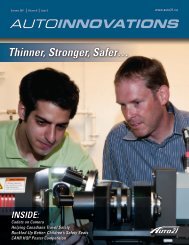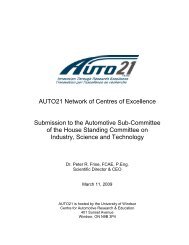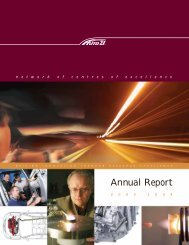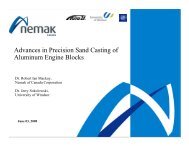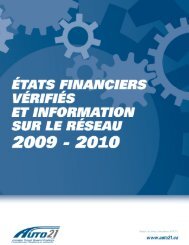Create successful ePaper yourself
Turn your PDF publications into a flip-book with our unique Google optimized e-Paper software.
Table-3.3.6: Seat belt status by population size of driver’s community.CategorySeat Belt StatusLiving Status Belted UnbeltedTotalLarge city(over 100,000) 657(98.9%) 7(1.1%) 664Large town or small city(10,000-100,000)531(98.0%) 11(2.0%) 542Small town(under10,000)440(97.1%) 13(2.9%) 453Total 1628(98.1%) 31(1.9%) 16593.4 Weighted Estimates of Various Correct Variables for theParking Lot DataIn what follows we carry out weighted analysis of correct use rates based onsurvey methodology. Here we give a summary of the estimation procedure:The sampling frame was stratified by province and by region, according to theStatistics Canada’s definition of census regions (see Chounard, 2004). The totalpopulation of children younger than 17 years per province and per region withinprovince for the year 2004 was extracted from Statistics Canada’s data base byAline Chouinard of Transport Canada. Let h=1,…,m indicate the strata (region)within a given province, where m indicates the total number of regions in theprovince. Within each region we are ignoring the lower sampling stages such asthe intersection, the day of the week and the sampling time within a given day.The randomizations of those stages were largely violated due to practicality. Wehave opted to use a post-stratification procedure. Thus, we are assuming inwhat follows that, within each region in a province, the sample of vehiclesobserved at all sites in that region form a simple random sample withoutreplacement (SRSWOR). Also, in each vehicle observed there were a number ofchildren whose variables were recorded. Therefore, the vehicle forms a clusterand gives rise to correlated observations. Let i=1,..,m h indicate the i th clusterwithin the h th strata so that m h indicates the total number of vehicles observedwithin the h th strata. Finally, let j=1,…,m hi denote the j th observation (child) withinthe i th vehicle in the h th region (strata), so that m hi denotes the total number ofchildren (up to 3) in the i th vehicle observed in the h th region. First we obtainestimates of correct use for each region within a province and then we combinethese regional estimates to give a provincial estimate by using weightsproportional to the size of the region. That is, the region weights are equal to thechild population size of the province divided by the child population size of theregion. This amounts to assigning a weight of w = N / n to the observation ofhij h h25



